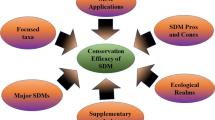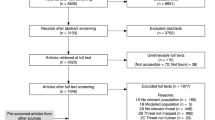Abstract
Within the Red List of the International Union for Conservation of Nature (IUCN), species distribution models (SDM) are used with two main purposes: (1) to estimate extents of occurrence as a parameter of risk of extinction and, more recently, (2) to explore potential impacts of climate change on species distribution. In this article I propose a third use of SDM: to generate objective and quantitative rankings of threats for the species categorized within the Red List. Although, some authors have published threat analyses based on SDM, most current ranking of threats conducted within IUCN Specialist Groups still relies on the subjective perspectives of workshop attendees or individual experts. I found that SDMs are ideal for incorporating theoretical and mathematical rigour to the ranking threat process, because: (1) they are of relatively easy and fast implementation, (2) they can be used with different levels of knowledge about the species in question, and (3) they are particularly suitable for use at the geographical scale for which the IUCN Red List is designed.
Similar content being viewed by others
References
Austin MP (2002) Spatial prediction of species distribution: an interface between ecological theory and statistical modelling. Ecol Model 157:101–118
Burgman MJ, Ferson S, Akcakaya HR (1993) Risk assessment in conservation biology. Chapman and Hall, London
Cassini MH (2011) Ecological principles of species distribution models: the habitat matching law. J Biogeogr (in press)
Elith J, Leathwick JR (2009) Species distribution models: ecological explanation and prediction across space and time. Annu Rev Ecol Evol Syst 40:677–697
Grantham HS, Wilson KA, Moilanen A, Rebelo T, Possingham HP (2009) Delaying conservation actions for improved knowledge: how long should we wait? Ecol Lett 12:293–301
Guisan A, Thuiller W (2005) Predicting species distribution: offering more than simple habitat models. Ecol Lett 8:993–1009
Hayward MW (2009) The need to rationalize and prioritize threatening processes used to determine threat status in the IUCN Red List. Conserv Biol 23:1568–1576
Heikkinen R, Luoto M, Aráujo MB, Virkkala R, Thuiller W, Sykes MT (2006) Methods and uncertainties in bioclimatic envelope modelling under climate change. Progr Phys Geogr 30:751–777
Hirzel AH, Hausser J, Chessel D, Perrin N (2002) Ecological-niche factor analysis: how to compute habitat suitability maps without absence data? Ecology 83:2027–2036
IUCN (2001) IUCN Red List categories and criteria: version 3.1. IUCN Species Survival Commission. IUCN, Gland, Switzerland ii + 30 pp
IUCN (2003) Guidelines for Application of IUCN Red List Criteria at Regional Levels: Version 3.0. IUCN Species Survival Commission. IUCN, Gland, Switzerland, ii + 26 pp
IUCN Standards and Petitions Subcommittee (2010) Guidelines for using the IUCN Red List categories and criteria. Version 8.1. Prepared by the Standards and Petitions Subcommittee in March 2010. http://intranet.iucn.org/webfiles/doc/SSC/RedList/RedListGuidelines.pdf. Accessed 5 June 2011
Pearson RG, Raxworthy CJ, Nakamura M, Townsend Peterson A (2007) Predicting species distributions from small numbers of occurrence records: a test case using cryptic geckos in Madagascar. J Biogeogr 34:102–117
Phillips SJ, Anderson RP, Schapire RE (2006) Maximum entropy modeling of species geographic distributions. Ecol Modell 190:231–259
Soulé ME (1985) What is conservation biology? Bioscience 35:727–734
Whittaker RJ, Araújo MB, Jepson P, Ladle RJ, Watson JEM, Willis KJ (2005) Conservation biogeography: assessment and prospect. Div Distr 11:3–23
Acknowledgment
This study was supported by grants from CONICET (PIP Nº 11420090100367) and the University of Luján (Fondos Finalidad 3.5).
Author information
Authors and Affiliations
Corresponding author
Rights and permissions
About this article
Cite this article
Cassini, M.H. Ranking threats using species distribution models in the IUCN Red List assessment process. Biodivers Conserv 20, 3689–3692 (2011). https://doi.org/10.1007/s10531-011-0126-9
Received:
Accepted:
Published:
Issue Date:
DOI: https://doi.org/10.1007/s10531-011-0126-9




